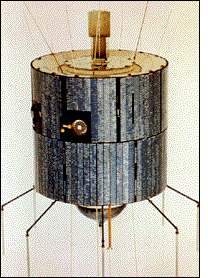cosmos.wikisort.org - Spacecraft
Applications Technology Satellite 3, or ATS-3, was a long-lived American experimental geostationary weather and communications satellite, operated by NASA from 1967 to 2001.[3] It was at one time reputed to be the oldest satellite still in operation.[4] As of 1995[update], NASA referred to the ATS-3 as "The oldest active communications satellite by a wide margin."[5]
 ATS-3 prelaunch | |
| Mission type | Weather Communications Technology |
|---|---|
| Operator | NASA |
| COSPAR ID | 1967-111A |
| SATCAT no. | 3029 |
| Mission duration | 3 years planned |
| Spacecraft properties | |
| Bus | HS-306 |
| Manufacturer | Hughes |
| Launch mass | 365.0 kilograms (804.7 lb) |
| Start of mission | |
| Launch date | November 5, 1967, 23:37:00 UTC[1] |
| Rocket | Atlas SLV-3 Agena-D |
| Launch site | Cape Canaveral LC-12 |
| Orbital parameters | |
| Reference system | Geocentric |
| Regime | GSO |
| Semi-major axis | 42,241.0 kilometres (26,247.3 mi) |
| Eccentricity | 0.00043 |
| Perigee altitude | 35,723 kilometers (22,197 mi) |
| Apogee altitude | 35,862 kilometers (22,284 mi) |
| Inclination | 6.92 degrees |
| Period | 23.93 hours |
| Epoch | January 21, 2014, 11:54:19 UTC[2] |

On November 10, 1967, ATS-3 took NASA's first color photo (digital image mosaic) of the full-disk Earth, which was subsequently used on the cover of the first Whole Earth Catalog.
History
Launched in November 1967, the ATS-3 was in service for 11 years before finally being decommissioned in 1978 along with ATS-1.[6] Among its widest-known achievements are the first full-disk, "true color"[7] composite Earth image (DODGE took color-filtered black-and-white images, put together they produced the very first color image of the full-disk).[8] Its imaging capability has served during disaster situations, from the Mexico earthquake to the Mount St. Helens eruption.[5]
ATS-3 experiments included VHF and C-band communications, a color spin-scan camera[9] (principally developed by Verner E. Suomi), an image dissector camera, a mechanically despun antenna, resistojet thrusters, hydrazine propulsion, optical surface experiments, and the measurement of the electron content of the ionosphere and magnetosphere.
Because of failures in the hydrogen peroxide systems on ATS-1, ATS-3 was equipped with a hydrazine propulsion system. Its success led to its incorporation on ATS-4 and ATS-5 as the sole propulsion system.[5]
Operational details
The satellite is in geo-synchronous orbit 34,047 kilometers (21,156 mi) above the Earth's surface. The satellite has served as a communications link for rescue operations, including the 1985 Mexico City earthquake and the 1980 eruption of Mount St. Helens.[10]
Circa 1970, ATS-3 was used to collect images of weather patterns, especially developing hurricanes in the Western Hemisphere. 1,200 line photos were downlinked, approximately every 25 minutes, during daylight hours to NOAA's Command and Data Acquisition Station at Wallops Station, Virginia and transferred to various users. The satellite was known for its spinning beam antennas locking up and rotating with the satellite. When that happened, it took a powerful ground-based transmitter, like the one at Mojave, to blast through digital instructions to get the antenna aimed back at earth again.[citation needed]

See also
- 1967 in spaceflight
- First images of Earth from space
- Applications Technology Satellite
References
- McDowell, Jonathan. "Launch Log". Jonathan's Space Page. Retrieved January 24, 2014.
- "ATS 3 Satellite details 1967-111A NORAD 3029". N2YO. January 21, 2014. Retrieved January 24, 2014.
- "ATS | Science Mission Directorate". science.nasa.gov. Retrieved October 27, 2016.
- "Technology". solarstorms.org. Archived from the original on September 28, 2006. Retrieved November 17, 2012.
- Glover, Daniel R. (1997). "Chapter 6: NASA Experimental Communications Satellites, 1958–1995, SP-4217 Beyond the Ionosphere". In Butrica, Andrew J. (ed.). Beyond The Ionosphere: The Development of Satellite Communications. NASA.
- "Applications Technology Satellite Program".
- Miller, Steven D.; Schmit, Timothy L.; Seaman, Curtis J.; Lindsey, Daniel T.; Gunshor, Mathew M.; Kohrs, Richard A.; Sumida, Yasuhiko; Hillger, Donald (October 1, 2016). "A Sight for Sore Eyes: The Return of True Color to Geostationary Satellites". Bulletin of the American Meteorological Society. American Meteorological Society. 97 (10): 1803–1816. Bibcode:2016BAMS...97.1803M. doi:10.1175/bams-d-15-00154.1. ISSN 0003-0007.
- "The First Color Images of the Earth from Space". Geography Realm. March 13, 2019. Retrieved February 2, 2022.
- "NASA – NSSDC – Experiment – Details – Multicolor Spin-Scan Cloudcover Camera (MSSCC)". NASA. Retrieved November 17, 2012.
- Pae, Peter, "Satellites' Longevity Limits Sales", Los Angeles Times, December 1, 2008, p. C1.
External links
На других языках
- [en] ATS-3
[es] ATS 3
ATS 3 (Applications Technology Satellite 3) fue un satélite artificial estadounidense dedicado a probar nuevas tecnologías y dar servicio de comunicaciones. Fue lanzado el 5 de noviembre de 1967 y puesto en órbita geoestacionaria. Los objetivos del satélite eran, entre otros, investigar técnicas de estabilización mediante giro y probar comunicaciones mediante VHF y banda C. Además proporcionó servicios de comunicaciones a áreas del océano Pacífico y la Antártida, transmitió los Juegos Olímpicos de México 1968, sirvió para las comunicaciones de emergencia en el terremoto de México de 1985 y durante el desastre del monte Saint Helens. Dio apoyo de comunicaciones durante los alunizajes del programa Apolo. También envió las primeras imágenes en color desde el espacio y retransmitió regularmente imágenes de la cubierta de nubes para estudios meteorológicos.Другой контент может иметь иную лицензию. Перед использованием материалов сайта WikiSort.org внимательно изучите правила лицензирования конкретных элементов наполнения сайта.
WikiSort.org - проект по пересортировке и дополнению контента Википедии
